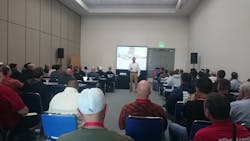Standing before a standing-room-only session at Firehouse World, Deputy Chief Jeff Case of the Phoenix Fire Department addressed a common fire response—the residential attic fire.
Although there are numerous factors to consider when managing residential attic fires, Case focused on two keys that go back to his department’s values—service excellence and communication. Specifically, he reminded attendees that “residential attic fires create a unique opportunity for fire departments to truly save property”—that it doesn’t have to be all destruction and water damage. Additionally, these fires require effective communication on scene to handle the multitude of tactical considerations, including the amount and location of fire; the color, pressure and location of smoke; building construction; on-scene resources; access for apparatus placement; heavy equipment on the roof; and the training and skill level of the crew.
Considering the several approaches to hitting an attic fire, Case delineated some of the many associated tactics and considerations:
- Attack from the underneath—converting the fire without initial vertical ventilation
- Attack from underneath with vertical ventilation
- Attack from the outside through the eaves
- Use of penetrating nozzle
- Salvage simultaneously with fire control efforts
- Gable end attack
- Roof attack with handlines
- Tactical thermal imagery
- Roof attack with penetrating nozzle
When it comes to the first-due engine, Case said the tactical and task functions are fairly standard. “Don’t get creative here,” he said. “There should still be a fast, aggressive interior attack, but don’t forget what you saw in your size-up.”
Case explained that one of the best tactics for knocking down an attic fire is through an eave attack, noting that “the engine company can get this done in a matter of minutes.” Specifically, crews can pop out the screens or boards in the eaves and direct a straight stream through the small hole, and then work the nozzle back and forth. He showed a video showing the effectiveness of this method, as the straight stream dispersed water in a wide area throughout the attic.
For a gable end attack, Case explained that “this is a dangerous operation if not practiced.” He offered several key considerations for this operation, including that the climbing angle is critical. He added that crews must be prepared for hoseline back pressure and pressurized, superheated smoke or fire escaping the gable opening.
When it comes to vertical ventilation, Case reinforced there must be a conscious decision about whether this tactic is necessary, based on initial size-up and ongoing conditions—not something that’s automatically done simply because it’s a standard operation.
Case added that if a coordinated roof attack is required, there are two options: 1) hitting the fire from an aerial ladder with penetrating nozzle from a platform and 2) working directly on the roof with handlines or penetrating nozzle.
An important point Case reiterated was that attic fire operations don’t have to destroy the rest of the home. If crews are pulling ceilings, there is sometimes time to move furniture or valuables out of the way beforehand. “We have to change the mindset to saving things over saving the attic,” he said. “When you do it [pull ceilings], you don’t have to do it on top of people’s stuff.”
To underscore his point about customer service and, Case wrapped his session on the phrase, “People, pets and property”—an important point about priorities on the incident scene—adding “that’s a Bruno quote.”
More from Firehouse World 2016
- Photos: Day 1 - Future Firefighter Program
- FHWorld16: Firehouse Ambassadors Get Lessons in Values
- FHWorld16: Fireground Air Management - A US/UK Perspective
- FHWorld16: Building a Robust Fire Dynamics Training Program
- FHWorld16: The Halligan Is a Valuable Tool on the Fireground
- FHWorld16: Sendelbach Poses Challenge to Fire Service
- FHWorld16: Chief Hood Says It's 'Time to Own It'
- FHWorld16: Leading Health Risks on the Modern Fireground
- FHWorld16: An International Look at Firefighting






